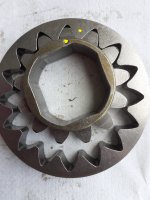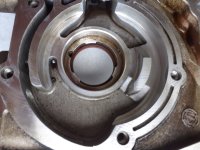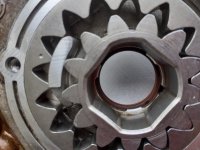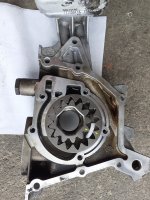Thanks for the pics, they make things a lot easier to understand. I too, am familiar with aligning 1 dot between 2 dots on 2 meshing gears e.g. old motorcycle engine valve timing etc. or to ensure that gears continue to mesh in the same way as they had 'bedded-in' to avoid possible problems.
I've done a bit of checking in some car workshop manuals I have (I don't have anything on the more modern models, just the old stuff) and found some info on a very similar oil pump that was fitted to the GM/Opel/Vauxhall 1.3 litre ohc engine of the 1980's. Here's the relevant page (below) - if you look at pic 38.4, it points to 'Gear outer face identification mark (arrowed), also in the text, paragraph 4 of section 38 Oil Pump - overhaul, it says " Note that the outer gear face is marked for position (photo)". On this engine the inner gear can only be fitted in one way but the outer gear could be fitted in 2 ways, so a mark is used to show the correct way.
I also checked a manual I have for the Toyota Corolla 2002 - 2007, this has a broadly similar oil pump and it states -"when reassembling, lubricate the pump rotors with clean engine oil and place them in the pump body with the marks facing the pump body cover side" i.e. the marks should be facing outwards - there's no mention of aligning them to each other or anything else. So, my reading of these marks is to simply show which are the outside sides of the gears/rotors when inserted in the pump body. Therefore imho, inserting the gears as per your pic # 4 should be fine,(famous last words

) as they are facing outwards and are also somewhat aligned with each other (even if it's not strictly necessary).
View attachment 437209





